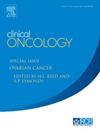Geometric and Dosimetric Evaluation of a RayStation Deep Learning Model for Auto-Segmentation of Organs at Risk in a Real-World Head and Neck Cancer Dataset
IF 3.2
3区 医学
Q2 ONCOLOGY
引用次数: 0
Abstract
Aims
To assess geometric accuracy and dosimetric impact of a deep learning segmentation (DLS) model on a large, diverse dataset of head and neck cancer (HNC) patients treated with intensity-modulated proton therapy (IMPT).
Materials and methods
A 3D U-Net-based DLS model was applied to CT datasets of 124 HNC patients treated with IMPT at 50.4–70.0 GyRBE. Thirty organs-at-risk (OARs), delineated manually (GT-OARs) were analysed for similarity metrics with auto-segmented OARs, without (DLS-nonedited) and with (DLS-edited) manual correction, using volume, Dice similarity coefficient (DSC), and Hausdorff distance (HD). Dosimetric impact of auto-segmentation error was assessed as absolute dose difference of mean (ΔDmean) and maximum (ΔDmax).
Results
The cohort includes patients with postoperative (47.6%), flap reconstruction (12.1%), mouth bites (79.8%), dental implants (54.8%), and surgical implants (3.2%). DLS failed in 11 patients with significant anatomical challenges and artifact. Compared with GT-OARs, DLS-nonedited under-segmented 11/12 Gr-A (central nervous system, arteries, bone) (p < 0.05) and over-segmented 13/18 Gr-B (glandular, digestive, airways) OARs. DSC scores were good (>0.8), intermediate (0.6–0.8), intermediate–poor (0.5–0.6), and poor (<0.5) in 12, 6, 4, and 8 OARs. HD were good (<4mm), intermediate (4–6mm), poor (6–8mm), and very poor (>8mm) in 5, 7, 4, and 14 OARs. Compared with manually corrected, DLS-edited OARs, all DLS-nonedited OARs demonstrated excellent similarity with DSC>0.8 and HD<4mm. On average, auto-segmentation took 2.51 minutes, while correction took 6.24 minutes. The mean values of ΔDmean and ΔDmax were within ±300 and ±3 cGyRBE, except for oesophagus and larynx, where the mean ΔDmean increases up to 837.14 cGyRBE.
Conclusion
Patient posture, nonbiological materials, and anatomical deformities influence DLS accuracy. The model’s overall performance is adequate and efficient with skilled manual editing needed for few OARs.
RayStation深度学习模型在真实世界头颈癌数据集中用于危险器官自动分割的几何和剂量学评估
目的评估深度学习分割(DLS)模型在接受调强质子治疗(IMPT)的头颈癌(HNC)患者的大型多样化数据集上的几何精度和剂量学影响。材料与方法将基于u - net的3D DLS模型应用于124例接受IMPT治疗的HNC患者的CT数据集。本研究分析了30个人工划定的高危器官(gt -桨)与自动分割桨的相似性指标,没有(dls -未编辑)和(dls -编辑)手动校正,使用体积,Dice相似系数(DSC)和Hausdorff距离(HD)。用平均绝对剂量差(ΔDmean)和最大剂量差(ΔDmax)评估自动分割误差对剂量学的影响。结果该队列包括术后(47.6%)、皮瓣重建(12.1%)、口腔咬伤(79.8%)、种植体(54.8%)和外科种植体(3.2%)患者。11例患者由于解剖上的挑战和伪影而失败。与GT-OARs相比,dls -未编辑的下节段11/12 Gr-A(中枢神经系统,动脉,骨)(p <;0.05)和过节段的13/18 Gr-B(腺、消化、气道)桨。12、6、4和8桨的DSC评分分别为良好(>0.8)、中等(0.6-0.8)、中等差(0.5 - 0.6)和差(<0.5)。5、7、4和14桨的HD为良好(> 4mm)、中等(4 - 6mm)、较差(6-8mm)和极差(>8mm)。与人工校正、dls编辑的桨相比较,所有未经dls编辑的桨与DSC>;0.8和HD<;4mm具有极好的相似性。自动分割平均耗时2.51分钟,而修正平均耗时6.24分钟。ΔDmean和ΔDmax的平均值在±300和±3 cGyRBE之间,除了食道和喉部,其平均值ΔDmean增加到837.14 cGyRBE。结论患者体位、非生物材料、解剖畸形影响DLS的准确性。该模型的整体性能是足够的和有效的,需要熟练的手动编辑少数桨。
本文章由计算机程序翻译,如有差异,请以英文原文为准。
求助全文
约1分钟内获得全文
求助全文
来源期刊

Clinical oncology
医学-肿瘤学
CiteScore
5.20
自引率
8.80%
发文量
332
审稿时长
40 days
期刊介绍:
Clinical Oncology is an International cancer journal covering all aspects of the clinical management of cancer patients, reflecting a multidisciplinary approach to therapy. Papers, editorials and reviews are published on all types of malignant disease embracing, pathology, diagnosis and treatment, including radiotherapy, chemotherapy, surgery, combined modality treatment and palliative care. Research and review papers covering epidemiology, radiobiology, radiation physics, tumour biology, and immunology are also published, together with letters to the editor, case reports and book reviews.
 求助内容:
求助内容: 应助结果提醒方式:
应助结果提醒方式:


